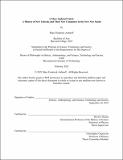A More Updated Union: A History of New Liberals and Their New Computers in the New New South
Author(s)
Aidinoff, Marc Frederick
DownloadThesis PDF (9.859Mb)
Advisor
Kaiser, David I.
Terms of use
Metadata
Show full item recordAbstract
By the end of the twentieth century, the United States welfare state itself seemed to exist inside of a computer system. Software and hardware mediated the experience of managing poverty. To seek entailments was to wait for a caseworker to find you in the system. This dissertation traces the computerization of the welfare state as an explicit reformatting of the liberal social contract from a localized system of uneven entitlements to a national regime of extraction.
Following the computerization of the welfare state leads not to Silicon Valley, but to the U.S. South. In a region lampooned as so behind politicians could campaign on promises to “never be last again,” networked computing served as a particularly alluring symbol and mechanism for what governance ought to be. There, Democrats, often organizing under the banner of “neoliberalism,” sought to rebuild their party’s electoral power by modernizing the mechanisms of government. Computerization—the social, cultural, and technological processes of designing, installing, and maintaining computer systems—inspired and confined new liberal policy and politics. It would strengthen racialized systems of power by transforming normative policy choices about classes of people into technological problems. Technical administrative institutions such as Mississippi’s Central Data Processing Authority (CDPA) and automated networked tools such as the Mississippi Application Verification Eligibility Reporting and Information Control System (MAVERICS) more than evidenced a new liberal ideology; they enabled and enacted it.
From 1968, when the state of Mississippi founded an agency to centralize government computing, to 2001, when a related state agency constructed a massive new facility to centralize the technology and technical personnel to collect incoming payments from citizens, the form and function of the U.S. welfare state changed. These shifts were epistemic—rooted in new ways the state could know the citizen—and operational—contingent on automated mechanisms to sustain administration. They served to reassign the responsibility of paying for welfare from the national or the state government to noncustodial parents. Local events demonstrated the persistence of welfare systems in an age of state retrenchment and codified national trends toward carceral welfare policy.
Tacking between local and national, this dissertation follows not only Southern Democrats, but also technological federalism, the interstate flow of technical experts and technological things. This approach highlights the mutual reinforcement of computerization and neoliberalization; just as technology structured ideas about what the state could and should do, these ideas materialized as technical systems. Foregrounding computerization leaves the welfare state in plain view—a state that did not disappear after the 1960s but took on a new form, with paperless tools to discipline and networked mechanisms to punish the private citizen
Date issued
2022-02Department
Massachusetts Institute of Technology. Program in Science, Technology and SocietyPublisher
Massachusetts Institute of Technology